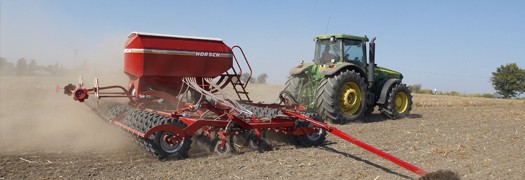Creating your own seed rate trials using MySOYL
Choosing the seed rate is a crucial decision that every grower has to make before drilling, but how can you ensure you're using the optimum rate for your field?
As well as the usual calculation, SOYL's MySOYL application – available as part of Frontier's MyFarm farm management platform - can help you to conduct specific trials to gain a better understanding of what really works for your farm and its conditions.
Getting the equation right
The standard method to calculate seed rate needs to take into account a number of factors.
Seed rate = Target Plant Population x TGW/establishment %
Of huge importance is getting the right plant population as it is vital for achieving optimum plant spacing and canopy size. A crop that is too thick will be more likely to lodge and suffer from higher disease pressure, whereas a crop that is too thin will be at increased risk of pest attack and is less able to compete with the weed population.
We know that, for example, 60% of seeds will establish on a heavy clay or limestone brash and 85% will establish on a sandy loam, but what is the total number of plants we should be aiming for?
Quite often this can be hard to measure and, as a result, many growers use standard rules of thumb or continue with historic rates that have been used on the farm for several years. In reality, there are numerous factors that need to be considered, many of which are extremely localised and therefore unique to the farm or even the individual fields. These could include:
- Climate and local conditions e.g. wet/dry seed bed
- Potential pest damage
- Varietal differences
- Tillering characteristics
- Effects of seed dressing.
Another important part of the equation is the % establishment of the drilled seed; that is how many plants will become established for every 100 seeds that are drilled. Not only will this change between fields but within single fields too.
To achieve the optimum seed rate, any variances can be easily accounted for by mapping the differences in soil texture using soil conductivity mapping. At SOYL, we have undertaken thousands of plant counts to create a range of % establishment for most soil types relating to soil texture, stone content, soil depth and landscape position.
Conducting trials
Through the use of variable rate drilling equipment, a simple trial can be set up to create plots of different seed rates to test for the optimum amount (see below).
These trials can be created and automated through our MYSOYL application. With a GPS yield map, the average yields for each plot can be measured and the seed rate that gives the highest yield can be established.
From the yield data a simple yield response curve can be plotted. In the examples above and below, the optimum seed rate for each of the three soil types tested was 48 seeds m². The yield reduced when rates were higher and lower than this optimum.
Over time, trials can be set up in different seasons to establish the correct rate in relation to weather conditions and drilling dates across the farm.
If you would like to know more about creating seed rate trials in MySOYL, please speak to your SOYL regional manager. For more information about MySOYL itself, please visit our website or email This email address is being protected from spambots. You need JavaScript enabled to view it..
As a subscriber, you’ll receive email alerts each time a new blog is published so you can always stay updated with the latest advice and insights from our experts







Comments